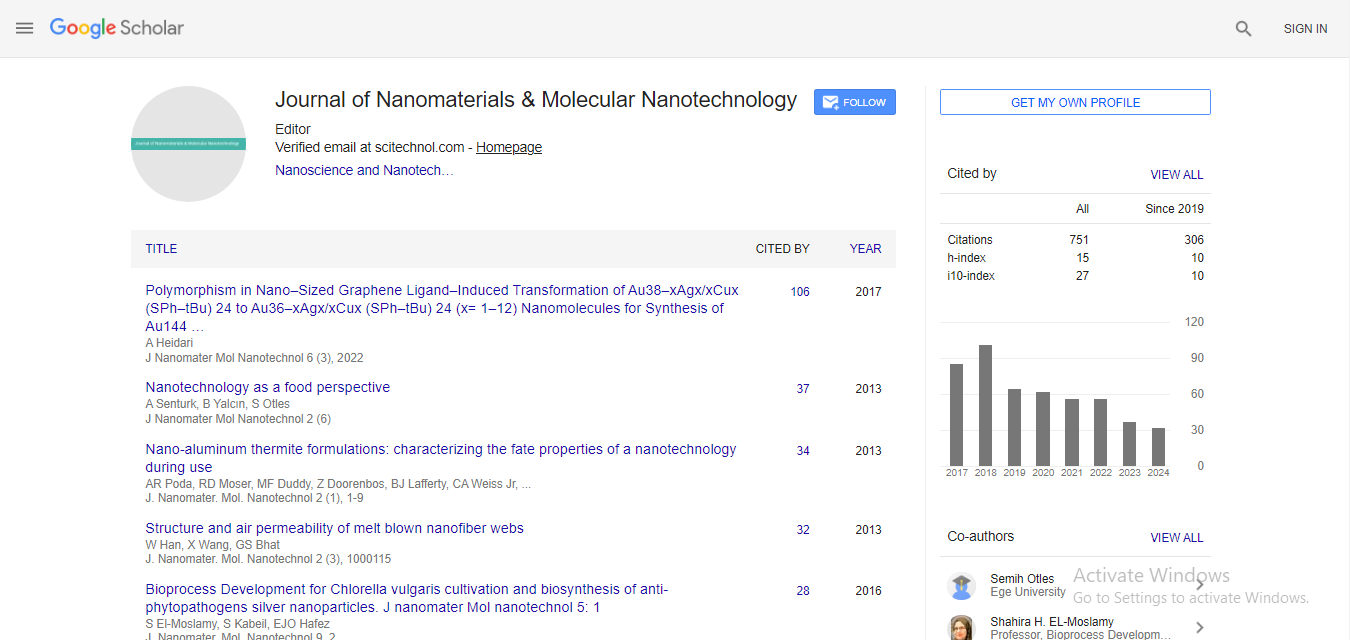Commentary, J Nanomater Mol Nanotechnol Vol: 11 Issue: 1
Oral Care Cosmetics with Nano Hydroxyapatite
Patrick Wang *
Department of Molecular Biophysics, University of Alberta, Edmonton, Canada
*Corresponding author: Patrick Wang
Department of Molecular Biophysics, University of Alberta, Edmonton, Canada
E-mail: patrickwang@gmail.com
Received date: 24 December, 2021, Manuscript No. JNMN-21-58133;
Editor assigned date: 27 December, 2021, PreQC No. JNMN-21-58133 (PQ);
Reviewed date: 10 January 2022, QC No. JNMN-21-58133;
Revised date: 17 January, 2022, Manuscript No. JNMN-21-58133 (R);
Published date: 24 January, 2022, DOI: 10.4172/2324-8777.2022.11(1).1000321
Citation: Wang P (2022) Oral Care Cosmetics with Nano Hydroxyapatite. J Nanomater Mol Nanotechnol 11:1.
Keywords: Nano Hydroxyapatite
Description
Nano-hydroxyapatite has been used as Associate in nursing oral care ingredient, being incorporated in much merchandise for the treatment of dental hypersensitivity and enamel demineralization. Despite its promising results, regulative and safety considerations are mentioned and questioned by the Scientific Committee on shopper Safety relating to the usage of hydroxyapatite nanoparticles in oral care merchandise. During this work, a commercially accessible nanohydroxyapatite was characterized and its cytocompatibility towards human animal tissue fibroblasts was evaluated, further as its irritation potential mistreatment the HET-CAM assay. All the conditions chosen during this study tried to simulate the tooth brushing procedure and also the hydroxyapatite nanoparticles levels unremarkably incorporated in oral care merchandise. The industrial hydroxyapatite nanoparticles employed in this study exhibited a rod-like morphology and also the expected chemical and part composition. The set of in vitro toxicity parameters accessed showed that these nanoparticles are extremely cytocompatible towards human animal tissue fibroblasts. In addition, these nanoparticles failed to possess any irritation potential on HET-CAM assay. This study clarifies the problems raised by SCCS and it concludes that this specific nano-hydroxyapatite is cytocompatible, as these nanoparticles failed to alter the traditional behavior of the cells. Therefore, they're safe to be employed in oral care merchandise.
Nanoparticles Precipitate
Hydroxyapatite is that the main mineral part of vertebrate bone and tooth, wherever this phosphate is gift as nanoscospic crystals. Artificial hydroxyapatite has been extensively used for many years in medical specialty applications thanks to its wonderful biocompatibility and osteogenic capability. Additional recently, hydroxyapatite nanoparticles (HA-NP) are incorporated in oral care merchandise to treat dentin hypersensitivity (DH) and promote enamel demineralization. DH could be a frequent oral health condition that affects up to half-hour of the adults in a very bound amount of their lives8. In patients with disease, the prevalence of DH will even reach 98%. During this condition, dentine tubules are exposed to the oral setting thanks to the presence of lesions within the enamel. As dentin tubules are hospitable the external setting, they're submitted to completely different stimuli that may reach the pulp nerves, leading to a brief and sharp pain. HA-NP is ready to scale back the pain related to DH since nanoparticles are sufficiently small to enter and fill the dentin tubules. The nanoparticles precipitate within the tubules and consequently block the interaction of the nerves with the external stimuli. HA-NP also can precipitate onto the enamel surface and remineralise initial enamel tooth decay, leading to the formation of a replacement mineral layer with inflated enamel surface hardness and so preventing caries. These positive results will be associated with HA-NP high similarity with enamel, in terms of morphology and crystal structure.
As HA-NP possess such sensible performance within the treatment of DH, a rising range of toothpastes and mouthwashes containing this nanomaterial emerged within the market within the last decade. However, the incorporation of those nanoparticles has raised many problems connected with their potential health risk for the customers, leading the eu Scientific Committee on shopper Safety to questioning the security of those nanoparticles as Associate in nursing oral care ingredient in their adopted Opinion. This document contains a security assessment with a comprehensive analysis concerning the pharmacological medicine potential of those nanoparticles as a cosmetic ingredient. Even with such thoroughgoing investigation wasn't ready to draw a final conclusion concerning the security of HANP. One amongst the explanations was the meager characterization of the nanoparticles, because the pharmacological medicine result could also be connected with options like size and morphology. Therefore, SCCS needs that the pharmacological medicine evaluations should be combined with a characterization of every ingredient severally.
In this work, commercially accessible HA-NP was evaluated for toxicity, envisaging their application within the treatment of dentin hypersensitivity. HA-NP particles were characterized in terms of morphology, size, area and chemistry. In vitro toxicity to human animal tissue fibroblasts was evaluated for cell viability metabolic activity, cell morphology, and F-actin structure organization, rate of capsize mediated cell death and generation of reactive gas species. In addition, the annoyance potential of those particles was assessed by the in vitro hen’s egg take a look at on the chorioallantois assay. All assays were performed in conditions trying to mimic tooth brushing procedure in terms of relevant cell kind, exposure time and HA-NP levels incorporated in oral care merchandise, so as to answer the considerations raised by the SCCS relating to the utilization of this nanomaterial in oral care merchandise.
Dentin hypersensitivity (DHS) could be a common clinical condition characterized by transient, sharp pain arising from exposed tooth dentin in response to external stimuli, usually thermal, phase change, tactile, electrical, osmotic, or chemical, that can't be attributed to the other dental malady. DHS is Associate in nursing exaggerated response that happens once benign information affects dentin tubules that became exposed thanks to animal tissue recession, loss of enamel, or loss of the solid body substance layer that covers the basis surface. The pain of DHS results in physical and psychological discomfort that may vary from a minor annoyance to chronic irritation. It’s the potential to negatively impact patients’ oral health Associate in Nursing quality of life as well as an adverse result on the patient’s ability to eat, drink, and maintain sensible oral hygiene.
Demineralization Method
One of the foremost common diseases that have affected the oral health of individuals round the world is caries. It will cause discomfort and pain, resulting in limitation in terms of practicality further as compromised facial aesthetics. It’s a vigorous alternating cyclic mechanism naturally happens between demineralization and demineralization of the mineral part on the tooth surface. The predominance of the demineralization method will cause tooth cavitation. Unhealthy lesion will be progressed or reversed betting on the balance between pathologic factors, as well as microorganism, spit dysfunction, possible carbohydrates, and protection mechanism of medicament and demineralization agents in spare securement. Initial tooth decay constitutes the preliminary proof of caries, wherever the enamel surface still remains intact whereas the subterranean layer is demineralized, thereby resulting in cavitation just in case no intervention is initiated. within the initial part of enamel demineralization, the prismatic mineral content is removed, that is later followed by a well-defined surface layer formation that accounts for Associate in Nursing early tooth decay lesion. The enamel demineralization method is slow in its progression, which allows the attainable reversal of mechanism if the method is detected early and managed adequately. Recently, the conservative approach in odontology has been applied to the demineralization method as associate in nursing best methodology to reconstruct the tooth structure. Early identification of tooth decay, beside a conservative treatment of the inchoate unhealthy lesion, will scale back variety of oral health care-related expenses. Recent analysis has turned to checking out advanced ways to find tooth decay at the earliest stage so as to create the utilization of a noninvasive treatment approach attainable.
 Spanish
Spanish  Chinese
Chinese  Russian
Russian  German
German  French
French  Japanese
Japanese  Portuguese
Portuguese  Hindi
Hindi 



